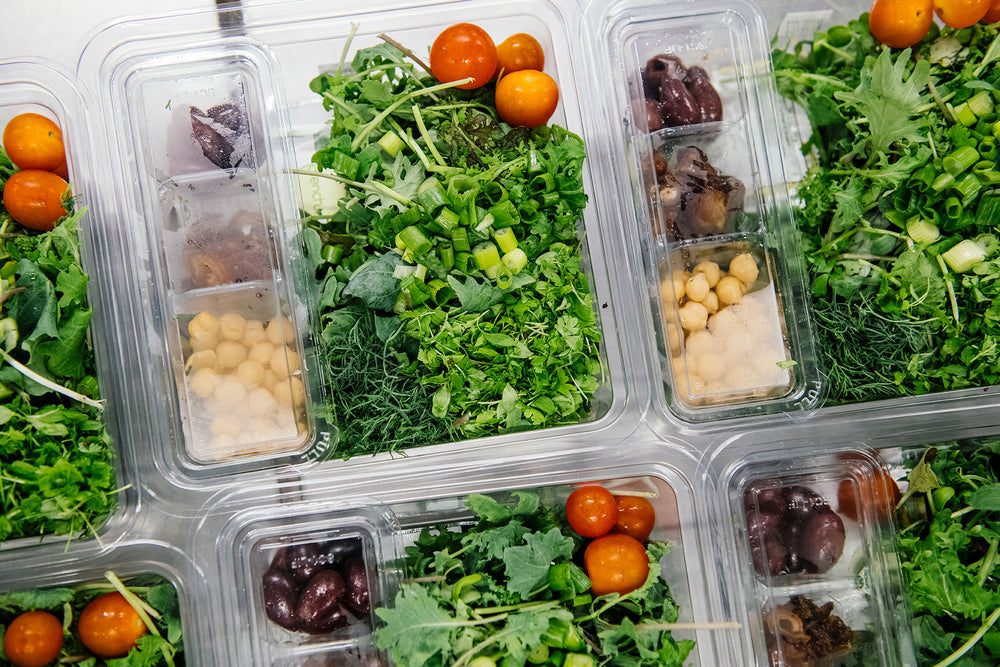
With a new year comes another season of kick starting self care, but how do you know where to start, especially when it comes to food? We tapped into our network to get some answers from Registered Dietitian Nutritionist Laura Ritacco. Read on to get the facts!

“Healthy eating” is a buzz phrase that gets thrown around across media sources, but what does it actually mean to “eat healthy” and is it something that really deserves our attention? The truth is, practicing healthy dietary habits is crucial in keeping our bodies in working order. We are constantly in motion, at both the cellular and macroscopic levels, using energy to fuel our bodies to move, breathe, think, sleep, and fight off infections. Food supplies the nutrients required to carry out these functions effectively; thus, building a healthy diet can help maintain optimal performance every day.
The first step to a healthy dietary pattern starts with incorporating each of the different food groups in every meal:
- Whole grains (think: whole wheat bread/tortillas, brown rice, and teff)
- Fruits (which range from berries to melons to citrus and beyond)
- Vegetables (tomatoes, yuca, beans, and greens such as kale, bok choy, and herbs)
- Dairy/dairy alternatives (milk products and alternatives from sources like soy, nuts, and seeds)
- Lean proteins (includes poultry without the skin, fish, and plant based foods like soy)
- Healthy fats (avocados, vegetable oils, and fatty fish such as salmon and sardines)
- Fluids (water, tea, and other non-sugar sweetened beverages)
These examples are not exhaustive of what a healthy diet includes. The types of food that belong to each group will likely be influenced by your geographical location and/or cultural background, leading to a variety of delicious options.
Moreover, healthy eating emphasizes foods that are nutrient dense. These foods are lower in sodium, added sugars, and unhealthy fats (e.g. saturated and trans fats, which can contribute to cardiovascular diseases if eaten in excess), but are high in vitamins and minerals, which can offer protective benefits. Whole grains, fruits, and vegetables are the most nutrient dense because they contain antioxidant substances, which help fight inflammation and prevent certain types of cancer. The most commonly known antioxidants are vitamin C, vitamin E, beta-carotene, and the minerals selenium and manganese. Other substances found in fruits and vegetables that help fight inflammation are phenolic compounds, which include flavonoids, phenolic acids, and tannins1. Vegetables such as salad greens, brassicas, and microgreens contain high amounts of these antioxidant properties. Altogether, these substances work to boost our immune system and brain health.
In addition to nutrient dense foods and antioxidants, a healthy diet includes the nutrient fiber. Fiber is a type of carbohydrate that cannot be broken down or digested by the gastrointestinal system, but offers many benefits. Fiber helps slow the rate of sugar absorption into the bloodstream once digested, which keeps blood sugar from spiking too high, and speeds up transit time in the digestive system (which can prevent harmful bacteria from accumulating in the gastrointestinal tract). Fiber keeps bowel movements regular to prevent constipation, and keeps you feeling fuller for longer, which can aid in weight management. Eating a diet high in fiber can help lower blood pressure and cholesterol while lowering the risk for diabetes, certain cancers, and inflammatory bowel diseases. The daily recommended amount of fiber varies based on age and biological sex, but is found in whole grain foods, nuts, seeds, fruits, and vegetables. When increasing your daily fiber intake, be sure to do so gradually and drink plenty of water to ensure a smoothly operating digestive tract.
Despite the importance of adequate fruit and vegetable consumption, the National Health and Nutrition Examination Survey (NHANES) shows that Americans typically don't meet recommended daily intakes2,3. It's important to incorporate fruits, vegetables, and whole grains with every meal to get the benefits of their rich vitamin, mineral, and fiber contents. At times, it may seem challenging to consume enough fruits and veggies when living in locations with longer winters and shorter growing seasons. However, with technological advances in farming practices, foods can be more accessible throughout the year. Locally grown produce can help nourish our bodies and our communities because it doesn't have to travel far to get to its destination. Some studies have shown that storage time, transport, light, and heat can cause certain nutrients to degrade, such as B vitamins, vitamin C, vitamins A and E, and other types of antioxidants4. Thus, consuming local produce can provide more nutrient dense options. Locally grown goods are also picked at peak freshness, which provides more robust flavor, compared to foods that travel from many miles away.
All in all, a healthy diet is one that emphasizes appropriate portion sizes of the different food groups. The types of foods we select reflect our cultural backgrounds and geographical locations, but should prioritize nutrient dense items. So, when choosing fruits and veggies for your meals, focus on eating a variety of rich colors to maximize your intake of different vitamins, minerals, and antioxidants. This bolsters the immune system and brain health; promotes healthy aging; and helps prevent chronic diseases. Whether you are just starting on your journey of adopting healthier eating habits or have already made progress, experimenting with new varieties of locally grown foods can be fun and provide you with the most nutrient rich and flavorful options. Cheers to healthy eating!
